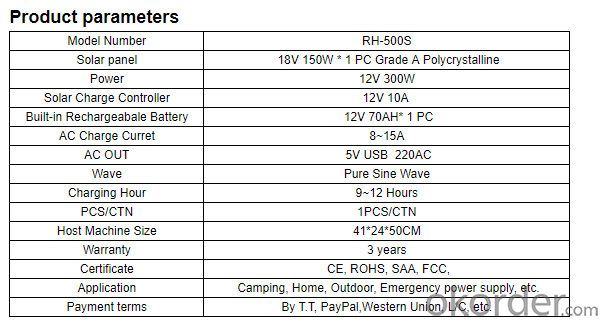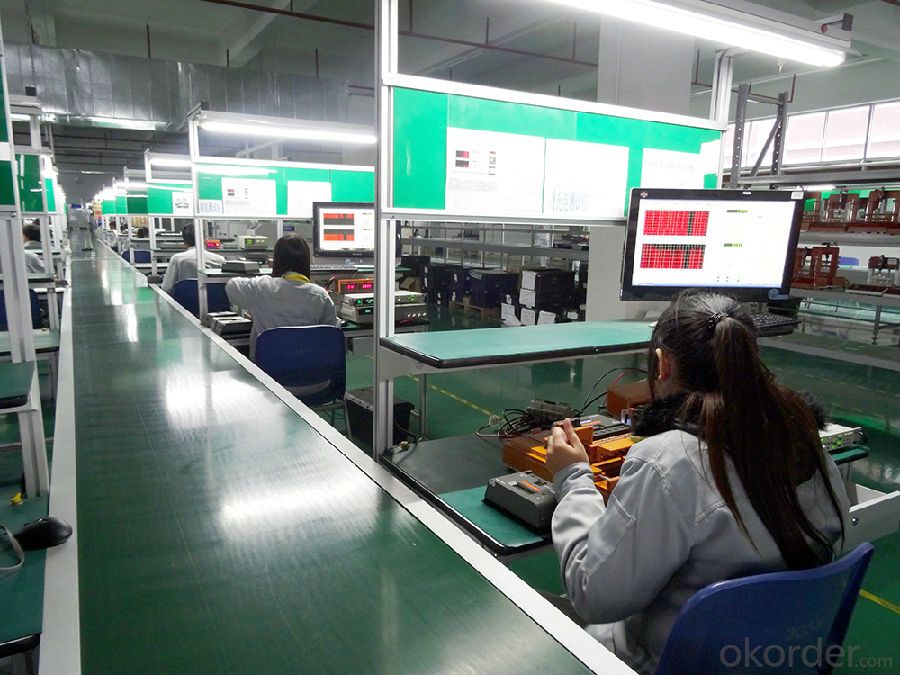oem ,odm ,500w, 1000w ,1500w lithium Portable home use solar energy system
- Loading Port:
- Shanghai
- Payment Terms:
- TT or LC
- Min Order Qty:
- 10 set
- Supply Capability:
- 5000 set/month
OKorder Service Pledge
OKorder Financial Service
You Might Also Like
Item specifice
This solar lighting system is ideal for places with no mains electricity such as outhouses, sheds, garages, farms, stables, as well as for camping, travel and any outdoor activities (e.g. a for a yurt).
The system is fully independent from the grid / AC power source and works purely based on sunlight energy.
During the daytime, the 12W solar panel charges a 12V battery inside the control unit, which then provides power to the 2 x 3W 12V LED lights connected via front sockets on the control unit.
In addition, there is a standard 5V USB socket for charging mobile phones and USB compatible devices (adaptors for USB-compatible mobile phones are included).
The control unit has a built-in 4Ah battery with an automatic solar charge controller to manage the charging process and prevent overcharging.
The 12W solar panel supplied with the system can fully charge this battery within about 7-8 hours of bright sunshine (longer in cloudy weather), and the battery can provide enough energy to power 2 LED lights continuously for 14 hours, or twice as long if only one LED lights are connected.
The system is very convenient to use and install: the solar panel comes with 5m cable and each LED light comes with 4m cable with an On/Off switch.


- Q:Can solar energy systems be used in areas with limited access to financing options?
- Yes, solar energy systems can be used in areas with limited access to financing options. There are various alternative financing options available such as leasing, power purchase agreements, and community funding that make solar energy more accessible to people in areas with limited financing options. Additionally, government incentives and subsidies can also help reduce the financial burden of installing solar energy systems in such areas.
- Q:Can solar energy systems be used for powering off-grid eco-cities?
- Yes, solar energy systems can be used for powering off-grid eco-cities. Solar panels can be installed in these eco-cities to harness the sun's energy and convert it into electricity. This renewable energy source can then be used to power various needs within the city, such as lighting, heating, and even charging electric vehicles. By relying on solar energy, off-grid eco-cities can reduce their carbon footprint and promote sustainable living.
- Q:Can solar energy systems be used for powering electric vehicle car-sharing programs?
- Yes, solar energy systems can be used to power electric vehicle car-sharing programs. By harnessing the sun's energy, solar panels can generate electricity to charge the batteries of electric vehicles and support their operations in car-sharing programs. This renewable energy source aligns well with the sustainability goals of electric vehicles and can contribute to reducing the carbon footprint of transportation.
- Q:Can solar energy systems be used for heating and cooling a home?
- Yes, solar energy systems can be used for heating and cooling a home. Solar heating systems, such as solar thermal collectors or solar water heaters, can be used to heat water or air for space heating purposes. Additionally, solar air conditioning systems, such as solar-powered absorption or desiccant cooling systems, can be used to cool a home using the energy from the sun.
- Q:Can solar energy systems be used in areas with limited space on rooftops due to existing equipment or structures?
- Solar energy systems can still be utilized in areas with limited rooftop space due to existing equipment or structures. In such instances, alternative approaches can be employed to optimize the use of available space. One possibility is to opt for ground-mounted systems rather than rooftop installations. These systems can be positioned in open areas adjacent to buildings or even on unused land nearby. Moreover, solar canopies or awnings can be set up in parking lots or other open spaces to generate solar power. These structures can be designed to offer shade and shelter while simultaneously harnessing solar energy. Consequently, even in areas with limited rooftop space, there are diverse and innovative options to implement solar energy systems.
- Q:Are there any disadvantages of solar energy systems?
- Yes, there are a few disadvantages of solar energy systems. Firstly, the initial installation cost can be high, making it less accessible for some individuals or communities. Secondly, solar panels require a large surface area to produce a significant amount of energy, which might be challenging in urban or limited space environments. Additionally, solar energy generation is dependent on sunlight, so it may not be as reliable during cloudy days or at night without the use of storage systems. Finally, the production and disposal of solar panels can have environmental impacts, particularly if not handled properly. However, despite these drawbacks, the benefits of solar energy, such as its renewable nature and reduced environmental impact, outweigh the disadvantages, making it a viable and increasingly popular energy option.
- Q:Can solar energy systems be used for powering industrial manufacturing plants?
- Yes, solar energy systems can be used for powering industrial manufacturing plants. With advancements in solar technology and the availability of large-scale solar panels, industrial manufacturing plants can harness solar power to meet their energy needs. This not only helps reduce reliance on fossil fuels but also contributes to cost savings and environmental sustainability in the long run.
- Q:Can solar energy systems be used for emergency backup power during power outages?
- Yes, solar energy systems can be used for emergency backup power during power outages. Solar panels generate electricity from sunlight, which can be stored in batteries for later use. This stored energy can then be used to power essential devices or appliances during an outage, providing a reliable source of backup power.
- Q:Can solar energy systems be used in historical or protected buildings?
- Yes, solar energy systems can be used in historical or protected buildings. In fact, incorporating solar energy systems into such buildings can be a smart and sustainable solution. While the installation of solar panels on historical or protected buildings might require careful planning and consideration, it is certainly possible to preserve the integrity and aesthetics of the architecture while benefiting from renewable energy sources. One approach to installing solar energy systems on historical or protected buildings is by using integrated solar panels. These panels are designed to blend seamlessly with the building's design and are installed in a way that does not alter the historical features. This can be achieved by placing the solar panels on flat roofs, using solar tiles, or installing solar panels on less visible parts of the building, such as the rear or sides. Another consideration when installing solar energy systems on historical or protected buildings is the preservation of the building's structural integrity. This can be done by employing non-penetrating mounting systems that do not require drilling or damaging the building's structure. Additionally, consultation with architects, engineers, and preservation experts is crucial to ensure the installation process adheres to any preservation guidelines or regulations. By embracing solar energy systems, historical or protected buildings can become more sustainable and reduce their carbon footprint. Solar panels can provide a clean and renewable source of electricity, reducing dependence on fossil fuels and decreasing greenhouse gas emissions. Moreover, solar energy systems can often generate enough power to meet the energy needs of these buildings, making them self-sufficient and potentially even providing surplus energy that can be fed back into the grid. In conclusion, solar energy systems can indeed be used in historical or protected buildings with careful planning and consideration. By utilizing integrated solar panels and consulting with preservation experts, it is possible to harness the benefits of renewable energy while preserving the architectural and historical value of these buildings. This approach not only ensures a sustainable future but also showcases the harmonious coexistence of modern technology and historical preservation.
- Q:Can solar energy systems be used in areas with limited access to solar energy installation services?
- Yes, solar energy systems can still be used in areas with limited access to solar energy installation services. In such cases, individuals or communities can opt for DIY solar panel installations or seek assistance from local technicians who have basic knowledge and skills in solar energy systems. Additionally, advancements in technology have made solar panels more accessible and affordable, allowing for easier installation and maintenance, even in remote areas.
1. Manufacturer Overview |
|
|---|---|
| Location | |
| Year Established | |
| Annual Output Value | |
| Main Markets | |
| Company Certifications | |
2. Manufacturer Certificates |
|
|---|---|
| a) Certification Name | |
| Range | |
| Reference | |
| Validity Period | |
3. Manufacturer Capability |
|
|---|---|
| a)Trade Capacity | |
| Nearest Port | |
| Export Percentage | |
| No.of Employees in Trade Department | |
| Language Spoken: | |
| b)Factory Information | |
| Factory Size: | |
| No. of Production Lines | |
| Contract Manufacturing | |
| Product Price Range | |
Send your message to us
oem ,odm ,500w, 1000w ,1500w lithium Portable home use solar energy system
- Loading Port:
- Shanghai
- Payment Terms:
- TT or LC
- Min Order Qty:
- 10 set
- Supply Capability:
- 5000 set/month
OKorder Service Pledge
OKorder Financial Service
Similar products
New products
Hot products
Related keywords

































